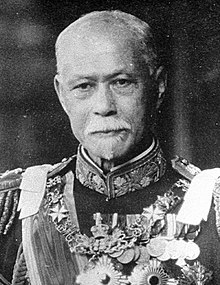Yamamoto Gonnohyōe
Admiral Yamamoto Gonnohyōe ( Japanese 山 本 権 兵衛 ; born November 26, 1852 in Kagoshima ; † December 8, 1933 , also called Gonbē / Gonbee / Gombē / Gombee in Kagoshima) was a Japanese military man and the 16th and 22nd Prime Minister of Japan .
He was born in Kagoshima Castle in Satsuma Province (now Kagoshima Prefecture ) as the son of a samurai of the Shimazu clan . After fighting on the side of Satsuma in the Boshin War , he studied successively at several state schools. He graduated from the Naval Academy in 1874 . From 1898 to 1906 he was Minister of the Navy . During this time he prepared the Russo-Japanese War and showed strength in leading the Japanese Navy . He recognized Togo Heihachiro's talent as an admiral and appointed him Chief Admiral of the Great Fleet of the Japanese Navy.
On September 21, 1907, Yamamoto was promoted to Hakushaku .
As a politician, he not only pursued the welfare of the naval administration, but also sought to maintain the balance between it and other parts of the government. He also sympathized with demands for a democratic and constitutional government. During his reign as prime minister , he abolished the rule that both navy and army ministers had to be active military officials. But due to the Siemens scandal , he resigned. In it, the government had been accused of having been bribed by Siemens to influence the procurement of naval ships. However, Yamamoto was innocent and only took responsibility for his subordinates.
In 1923 he was reappointed Prime Minister and showed leadership in rebuilding Tokyo after the Great Kanto earthquake . He tried to reform the franchise and give all adult men the right to vote without restriction. But he should have to resign again. On December 27, 1923, Namba Daisuke , a Japanese student, tried to assassinate Prince Regent Hirohito . The entire cabinet resigned out of shame that it had not been able to prevent the attack.
One day after his death he was posthumously awarded the highest Japanese order, the Chrysanthemum Order with Necklace.
Individual evidence
- ↑ This is an alternative reading in different spellings of the name characters and the first name more common in Japan.
- ↑ 大 勲 位 菊花 章 頸飾 ・ 大 勲 位 菊花 大 綬 章 受 章 者 一 覧 . (No longer available online.) The Nakano Library, archived from the original on September 14, 2013 ; Retrieved July 28, 2009 (Japanese). Info: The archive link was inserted automatically and has not yet been checked. Please check the original and archive link according to the instructions and then remove this notice.
Web links
| personal data | |
|---|---|
| SURNAME | Yamamoto, Gonnohyōe |
| ALTERNATIVE NAMES | 大 隈 重 信 (Japanese); Yamamoto Gonbē; Yamamoto Gonbee; Yamamoto Gonbe; Yamamoto Gombē; Yamamoto Gombee; Yamamoto Gombe |
| BRIEF DESCRIPTION | 16th and 22nd Prime Ministers of Japan |
| DATE OF BIRTH | November 26, 1852 |
| PLACE OF BIRTH | Satsuma Province |
| DATE OF DEATH | December 8, 1933 |

